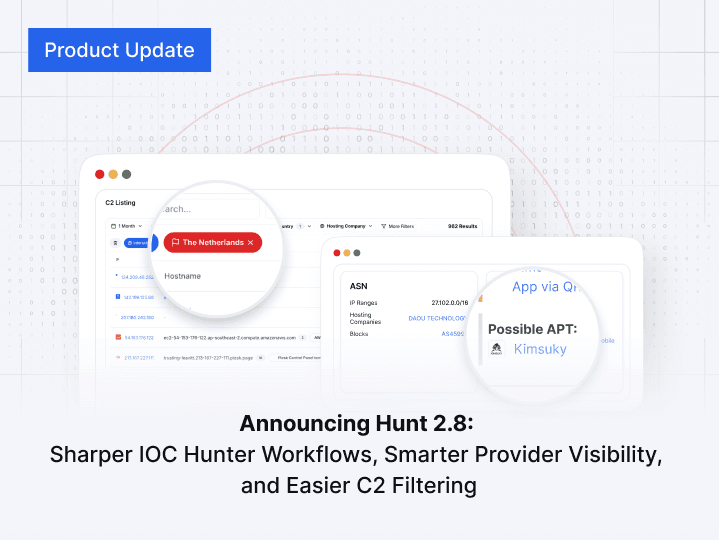Hunt.io Exposes and Analyzes ERMAC V3.0 Banking Trojan Full Source Code Leak
Published on
Published on
Published on
Aug 14, 2025
Aug 14, 2025
Aug 14, 2025





In March 2024, Hunt.io discovered and obtained the complete ERMAC V3.0 source code, giving us a rare opportunity to study a live and actively maintained Malware-as-a-Service platform from the inside. Full source code leaks of active and operational threats are uncommon, and this one offers a unique chance for attribution, infrastructure mapping, and identifying exploitable weaknesses.
Its earliest versions were built using the leaked Cerberus source code, and by late 2023, version 2.0 had incorporated large portions of the Hook botnet's codebase. The newly uncovered version 3.0 reveals a significant evolution of the malware, expanding its form injection and data theft capabilities to target more than 700 banking, shopping, and cryptocurrency applications.
This post examines the backend, frontend panel, exfiltration server, and builder included in the leak, detailing ERMAC's infrastructure, operational techniques, and multiple vulnerabilities that could be leveraged to disrupt its activity.
Key Takeaways
Our analysis of the ERMAC V3.0 leak uncovered technical details, operational weaknesses, and active infrastructure that defenders can use to disrupt ongoing campaigns.
Hunt.io obtained the full ERMAC V3.0 source code, including its PHP and Laravel backend, React-based frontend, Golang exfiltration server, and Android builder panel.
The leak revealed critical weaknesses, such as a hardcoded JWT secret and a static admin bearer token, default root credentials, and open account registration on the admin panel
Version 3.0 expands targeting to more than 700 financial, shopping, and cryptocurrency apps, adds new form injection methods, an overhauled C2 panel, a new Android backdoor, and AES-CBC encrypted communications
Analysis with HuntSQL linked the leaked files to active ERMAC C2 panels, exfiltration servers, and builder deployments still operating online.
Findings confirm ERMAC's role as a maintained Malware-as-a-Service platform, giving operators flexible control over targeting, encryption keys, and campaign creation
Initial Discovery
The investigation began on March 6th, 2024, when our research team, using the AttackCapture™ tool, identified an open directory on 141[.]164[.]62[.]236:443 containing an archive titled Ermac 3.0.zip. This archive held the complete ERMAC V3.0 source code.
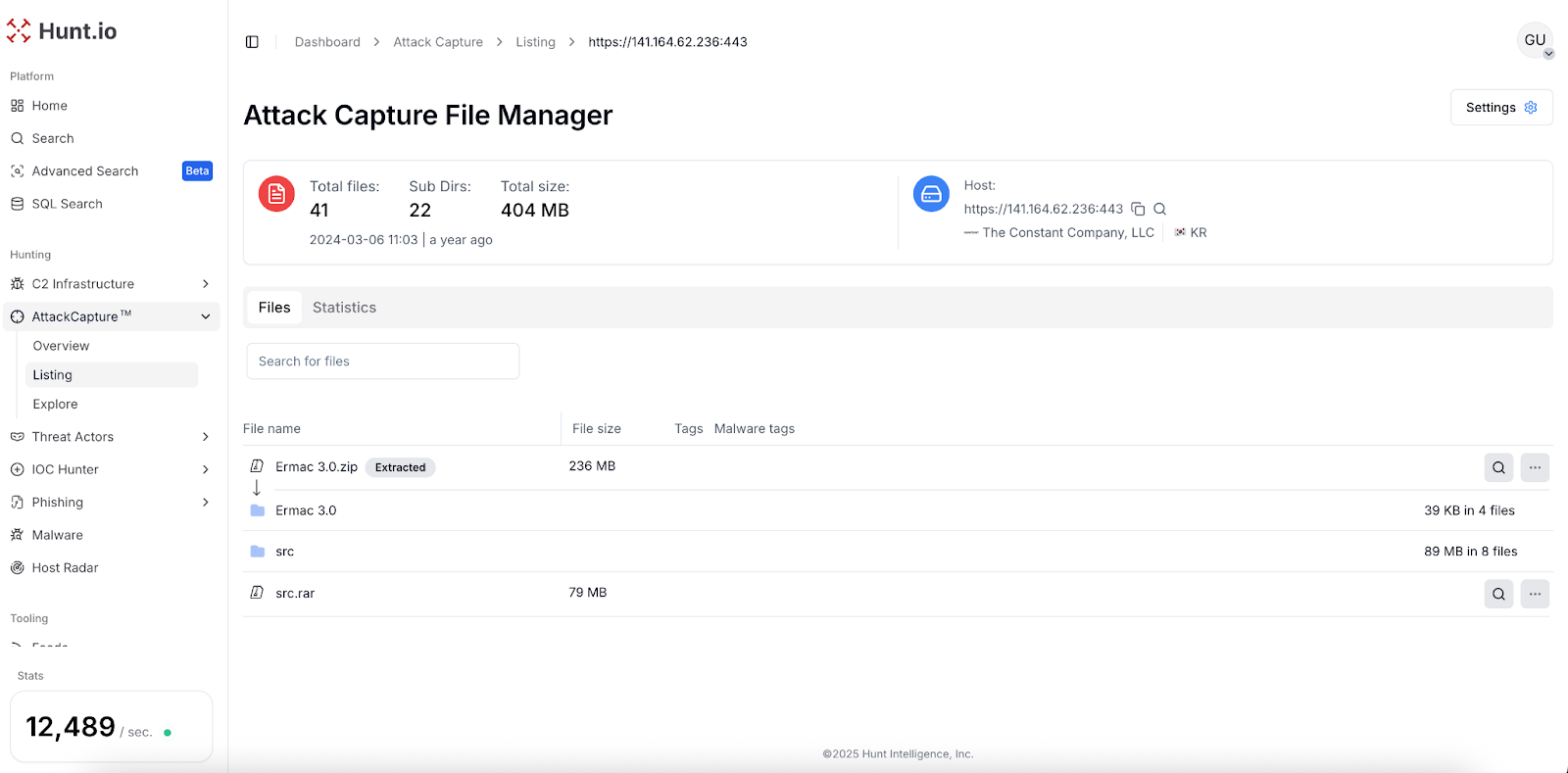 Fig 01: Open directory containing ERMAC's source code, discovered by Hunt.io
Fig 01: Open directory containing ERMAC's source code, discovered by Hunt.ioUpon further analysis, the Ermac 3.0.zip archive was found to contain 5 different directories:
backend: The ERMAC C2 backend, written in PHP.
frontend: The ERMAC C2 frontend, written in React.
golang: A Go binary that configures an HTTP server used in the exfiltration of data.
docker: Docker configuration files.
builder: Source code to ERMAC 3.0 banking trojan and a panel allowing for compilation and obfuscation of the APK.
Backend C2 Server
Looking into ERMAC's backend source code, we can see it's developed in PHP and uses Laravel as its backend framework. The codebase shares no overlap with the leaked Cerebus source code, with it implementing different routing, infrastructure logic, and features.
| Method | Route | Auth Required |
|---|---|---|
| POST | /api/v1/sign-in | No |
| POST | /api/v1/smartInjections/{sessionId} | No |
| POST | /api/v1/smartInjections/session/list | No |
| PUT | /api/v1/smartInjections/session/{session} | No |
| GET | /api/v1/getUserInfo | Yes |
| POST | /api/v1/injects/getInjectionsList | Yes |
| POST | /api/v1/injects/createInjection | Yes |
| DELETE | /api/v1/injects/deleteInjection | Yes |
| POST | /api/v1/injects/{injection}/editInjection | Yes |
| POST | /api/v1/sendBotsCommand | Yes |
| DELETE | /api/v1/deleteBot | Yes |
| DELETE | /api/v1/deleteAllRemovedApp | Yes |
| PUT | /api/v1/{bot}/setBotType | Yes |
| GET | /api/v1/{bot}/commands/getCommandsList | Yes |
| PUT | /api/v1/{bot}/settings/updateBotSettings | Yes |
| PUT | /api/v1/{bot}/injects/updateBotInjections | Yes |
| DELETE | /api/v1/deleteLog | Yes |
| PUT | /api/v1/editLogComment | Yes |
| POST | /api/v1/accounts/getAccountsList | Yes |
| POST | /api/v1/accounts/createAccount | Yes |
| PUT | /api/v1/accounts/{user}/editAccount | Yes |
| DELETE | /api/v1/accounts/{user}/deleteAccount | Yes |
| POST | /api/v1/permissions/getPermissionsList | Yes |
| PUT | /api/v1/permissions/updatePermission | Yes |
| POST | /api/v1/counts/getCounts | Yes |
| POST | /api/v1/counts/getStats | Yes |
| POST | /api/v1/autoCommands/getAutoCommandsList | Yes |
| PUT | /api/v1/autoCommands/updateAutoCommand | Yes |
| POST | /api/v1/search | Yes |
Reviewing these routes reveals the scope of control ERMAC operators have over infected devices and stolen data.
The ERMAC backend provides operators the ability to manage victim devices and access compromised data, such as SMS logs, stolen accounts, and device data.
ERMAC primarily leverages form injects for capturing sensitive data, which is done by serving custom form injects through the public/injects directory.
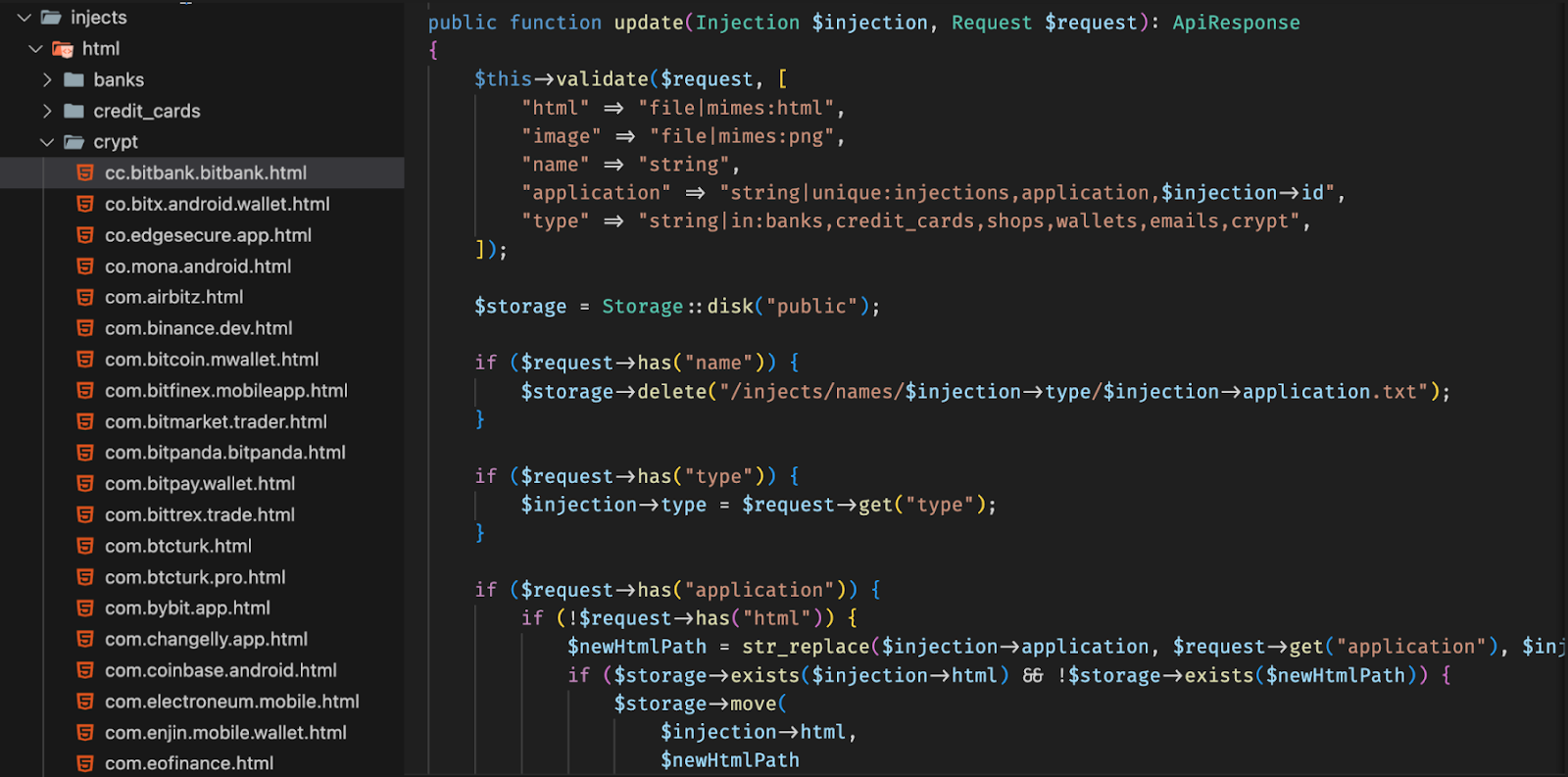 Fig 02: ERMAC's backend directory containing form injects for popular financial apps.
Fig 02: ERMAC's backend directory containing form injects for popular financial apps.ERMAC targets primarily financial applications with a large focus on mobile banking and cryptocurrency applications with it, capturing sensitive data such as login credentials or credit card data.
 Fig 03: Form Inject mimicking a banking app, and its callback function for exfiltrating form data.
Fig 03: Form Inject mimicking a banking app, and its callback function for exfiltrating form data.ERMAC will fetch and inject its own custom HTML page into 700+ different applications that uses the callback function
Android.send_log_injects to exfiltrate form data.
ERMAC's backend uses the
ermac_session cookie to handle authentication, which allows us to pivot and find other active backends. Using Hunt's SQL search, we are able to find 4 more unique ERMAC C2 servers in the wild:
SELECT * FROM httpv2
WHERE http.headers.bytes.content
LIKE '%ermac_session%'
CopyOutput:
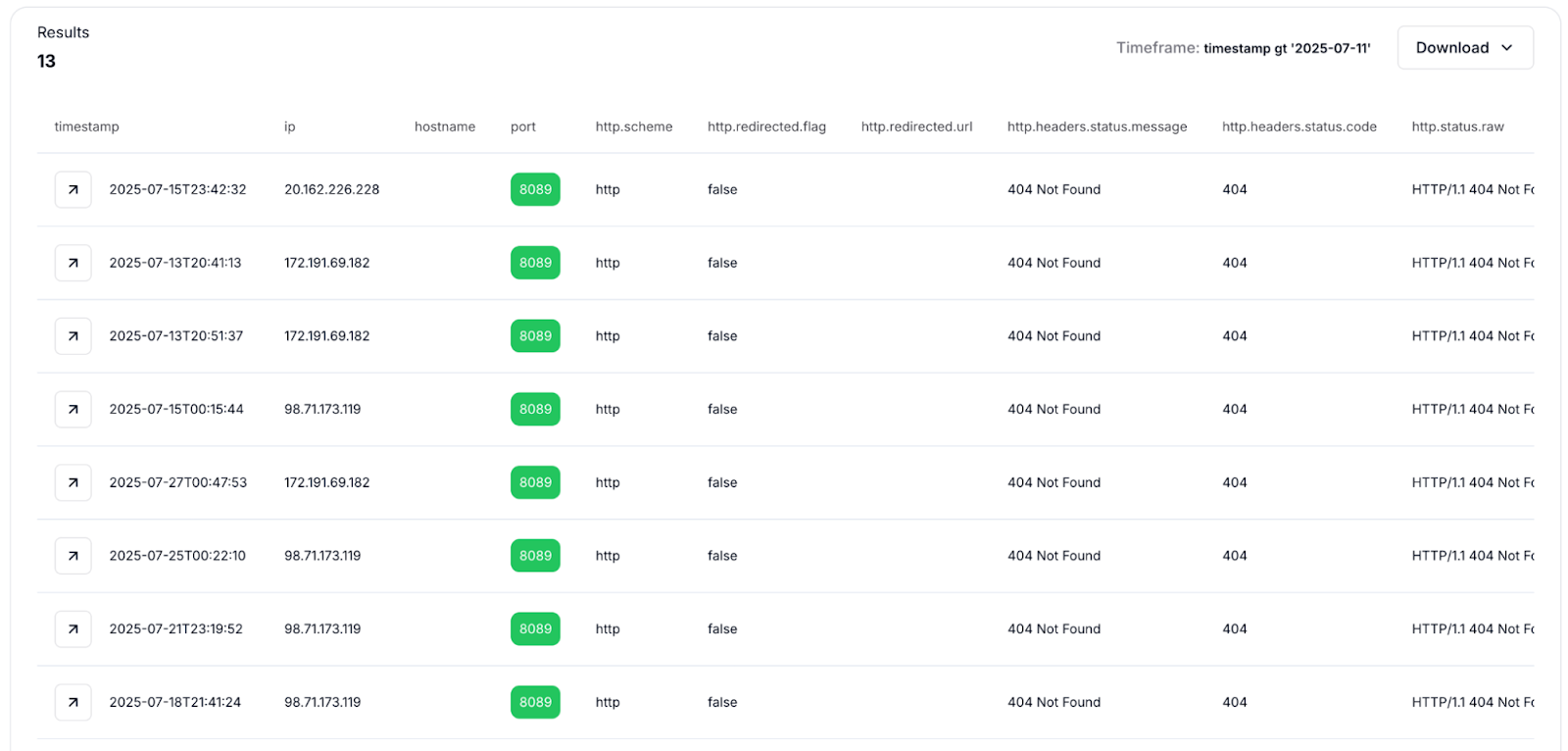 Fig 04: ERMAC C2 Servers observed having the ermac_session cookie.
Fig 04: ERMAC C2 Servers observed having the ermac_session cookie.Upon further analysis, ERMAC has three vulnerabilities: a hardcoded JWT token "
h3299xK7gdARLk85rsMyawT7K4yGbxYbkKoJo8gO3lMdl9XwJCKh2tMkdCmeeSeK", the hardcoded credentials for root with the password changemeplease, and the ability to register an account directly through the API, allowing for full access to the ERMAC admin panel.
 Fig 05: Hardcoded default credentials for ERMAC
Fig 05: Hardcoded default credentials for ERMACFrontend Panel
To complement the Backend C2, ERMAC provides a panel for interacting with the backend. ERMAC is observed to have three public versions, with the latest known version being 3.0
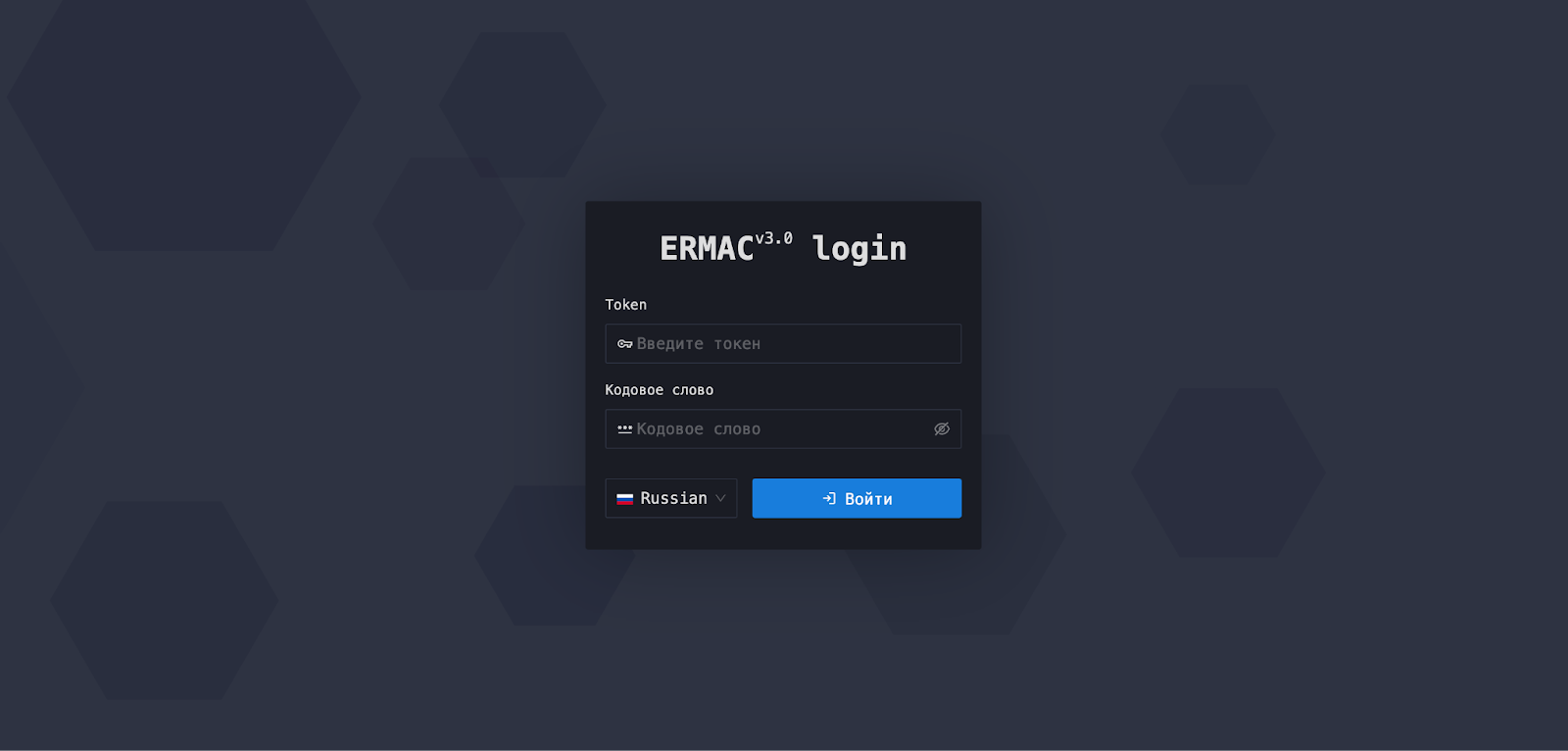 Fig 06: ERMAC V3.0 Panel Login
Fig 06: ERMAC V3.0 Panel LoginAll ERMAC panels notably have the page title "ERMAC 3.0 PANEL" allowing us to find 43[.]160[.]253[.]145 and 91[.]92[.]46[.]12. Upon simplifying this query, we can find an additional IP belonging to an older ERMAC panel: 206[.]123[.]128[.]81
SELECT * from httpv2
WHERE html.head.title = 'ERMAC 3.0 PANEL'
CopyOutput:
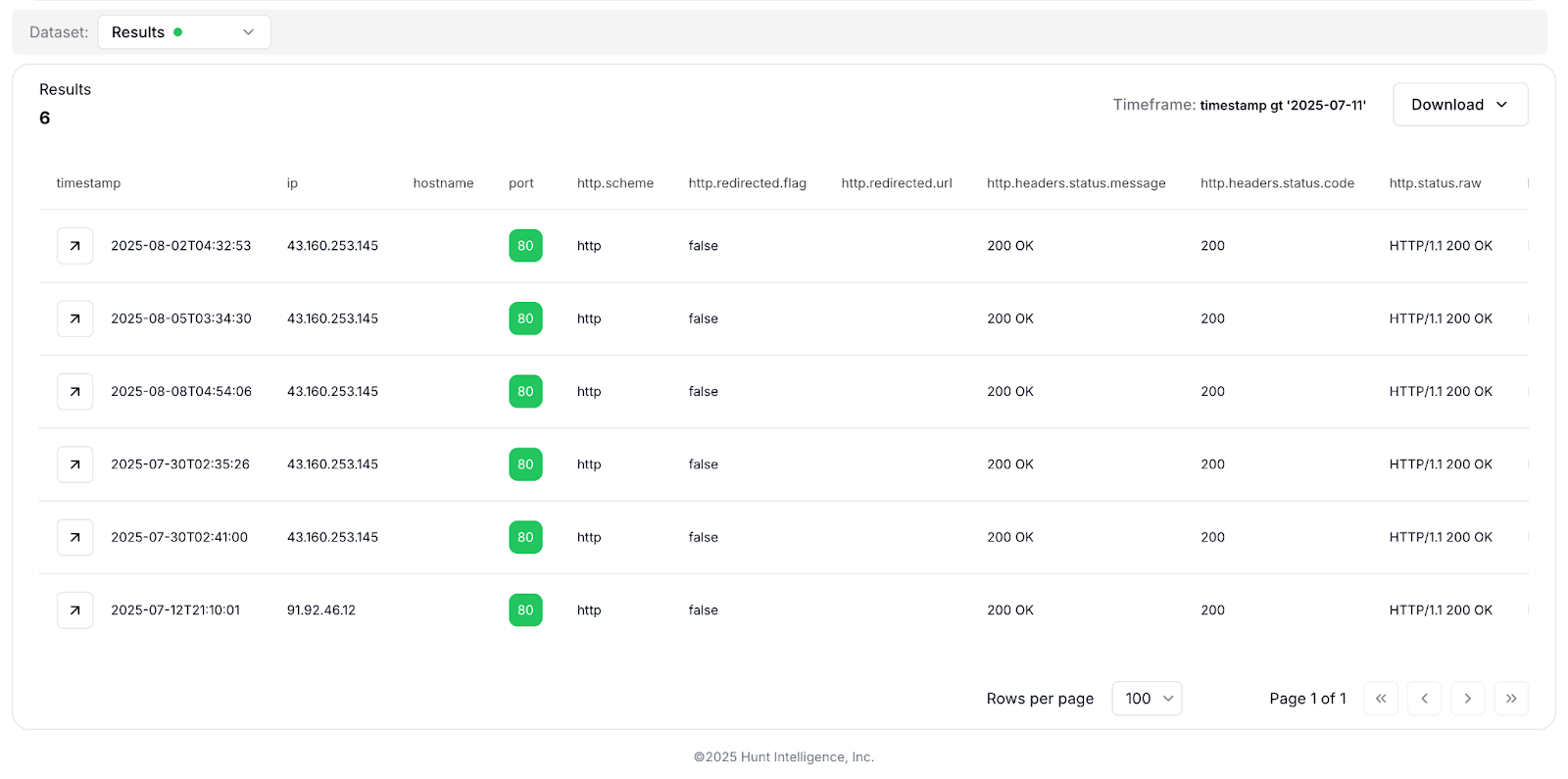 Fig 07: Results from searching for hosts with the ermac_session cookie, observed via HuntSQL by Hunt.io
Fig 07: Results from searching for hosts with the ermac_session cookie, observed via HuntSQL by Hunt.ioFrom within the panel, operators are able to interact with connected devices by issuing commands or accessing stolen data.
 Fig 08: ERMAC Panel UI
Fig 08: ERMAC Panel UIThis is accompanied by the ability to manage form injects directly through the panel, with the ability to enable or disable targeting of specific applications.
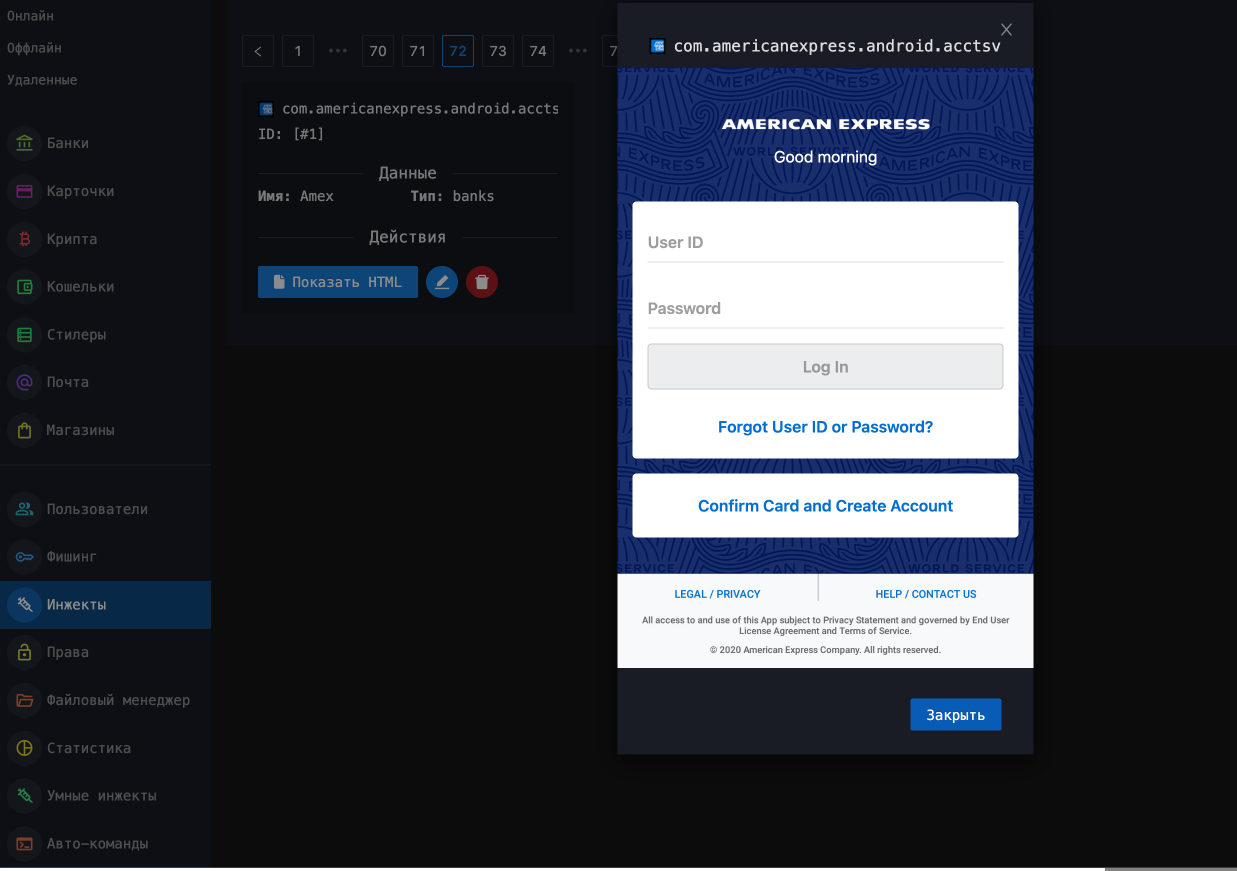 Fig 09: Form inject management system with adversaries able to upload and modify targeted applications.
Fig 09: Form inject management system with adversaries able to upload and modify targeted applications.Exfiltration Server
ERMAC is observed using a second server for exfiltrating stolen data. The exfiltration server is developed in Golang and provides an encrypted HTTP API for receiving exfiltrated data and managing information related to compromised devices.
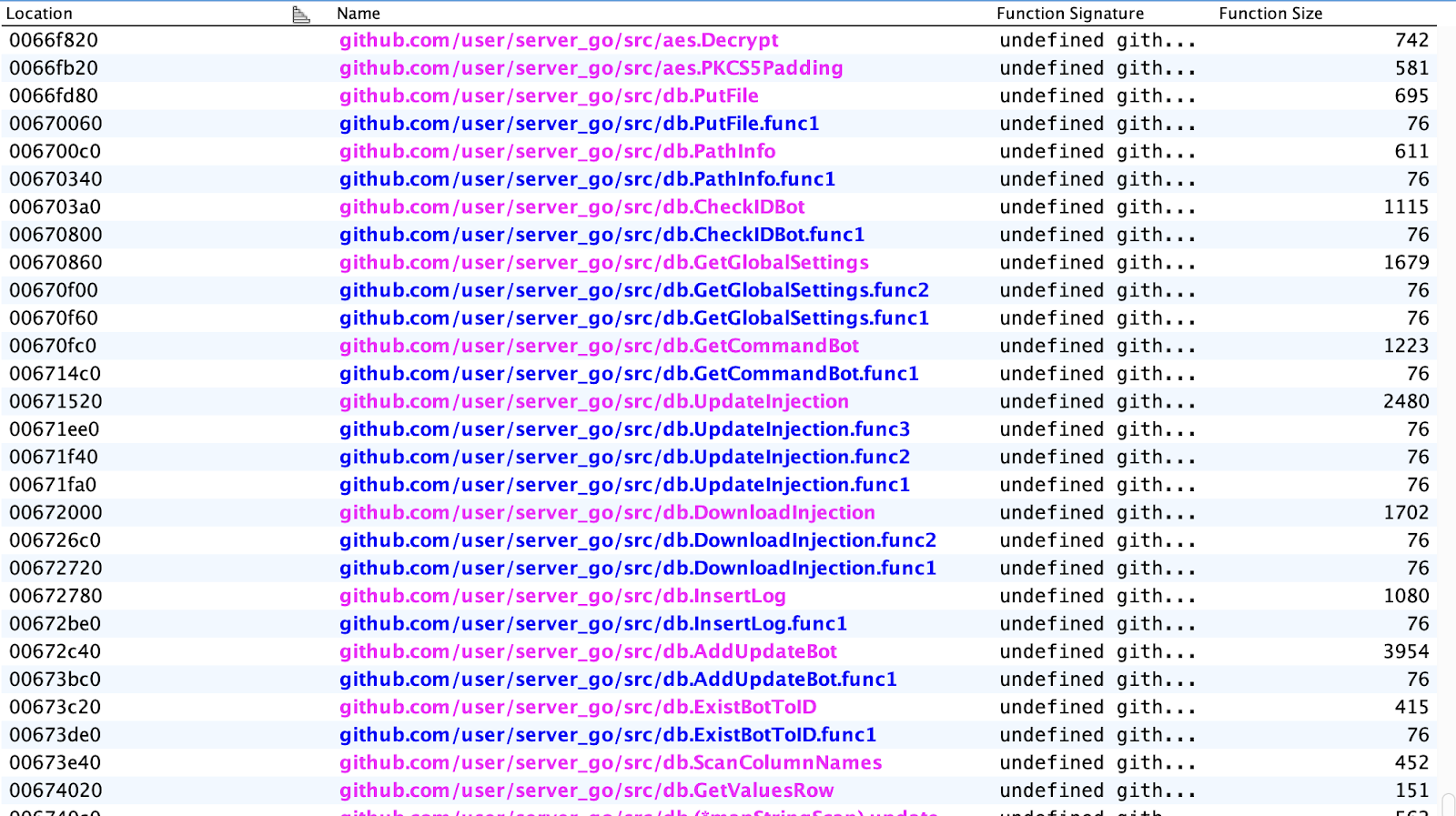 Fig 10: server_go exfiltration binary with the functions and libraries used.
Fig 10: server_go exfiltration binary with the functions and libraries used.The usage of a separate server is likely to hide the main C2 panel, with operators able to use isolated servers for exfiltration.
ERMAC exfiltration servers are commonly seen using HTTP basic authentication with the following header
Www-Authenticate: Basic realm="LOGIN | ERMAC". By querying Hunt's SQL httpv2 dataset, we were able to identify four more unique exfiltration servers used by ERMAC.
SELECT * FROM httpv2
WHERE http.headers.bytes.content like '%LOGIN | ERMAC%'
CopyOutput:
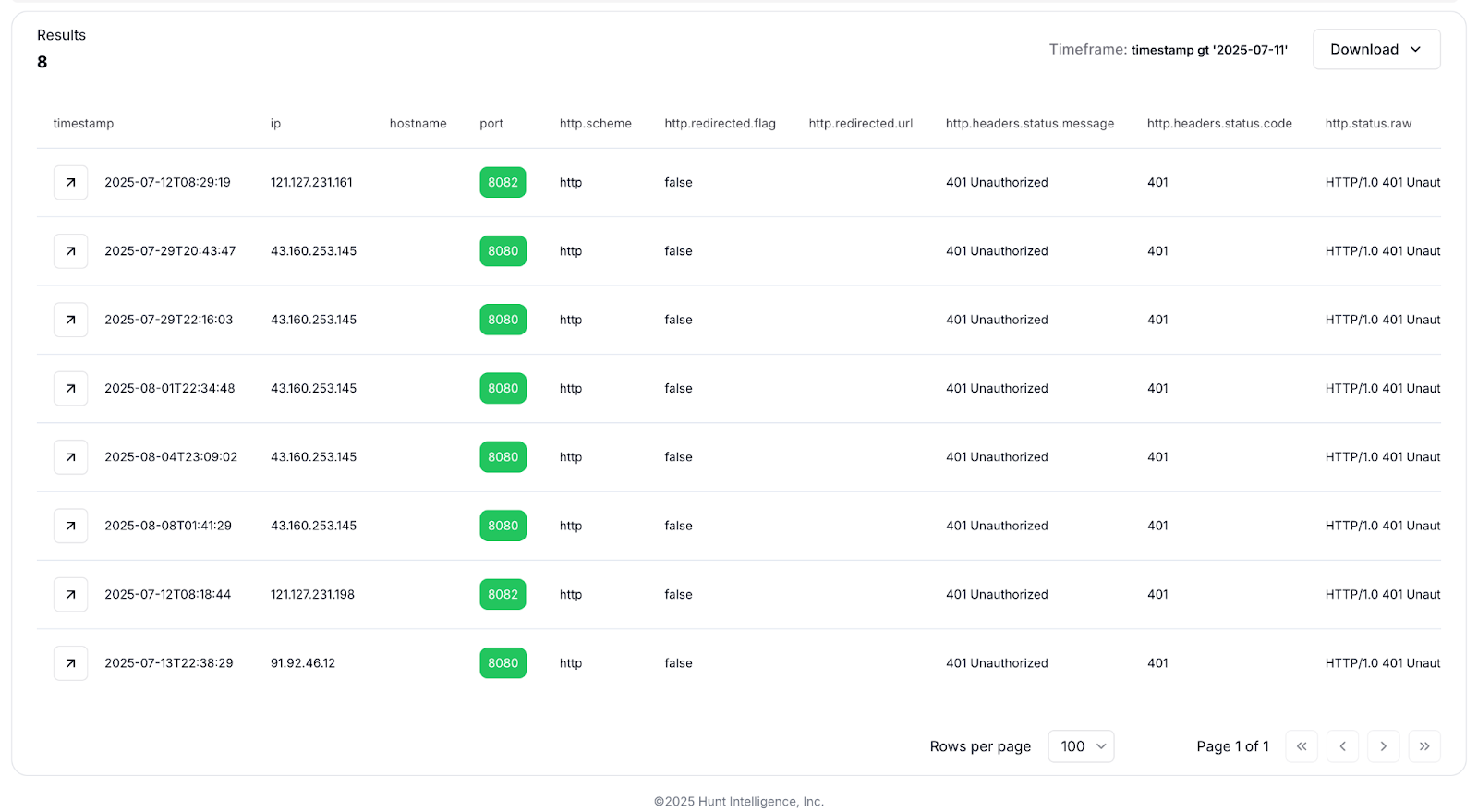 Fig 11: Public ERMAC Exfiltration Servers found with HuntSQL™
Fig 11: Public ERMAC Exfiltration Servers found with HuntSQL™ERMAC Backdoor
ERMAC leverages an Android backdoor developed in Kotlin, which provides control of the compromised device. The Android application supports 71 different languages, with it providing operators the ability to configure encryption keys, C2 servers, and the application settings.
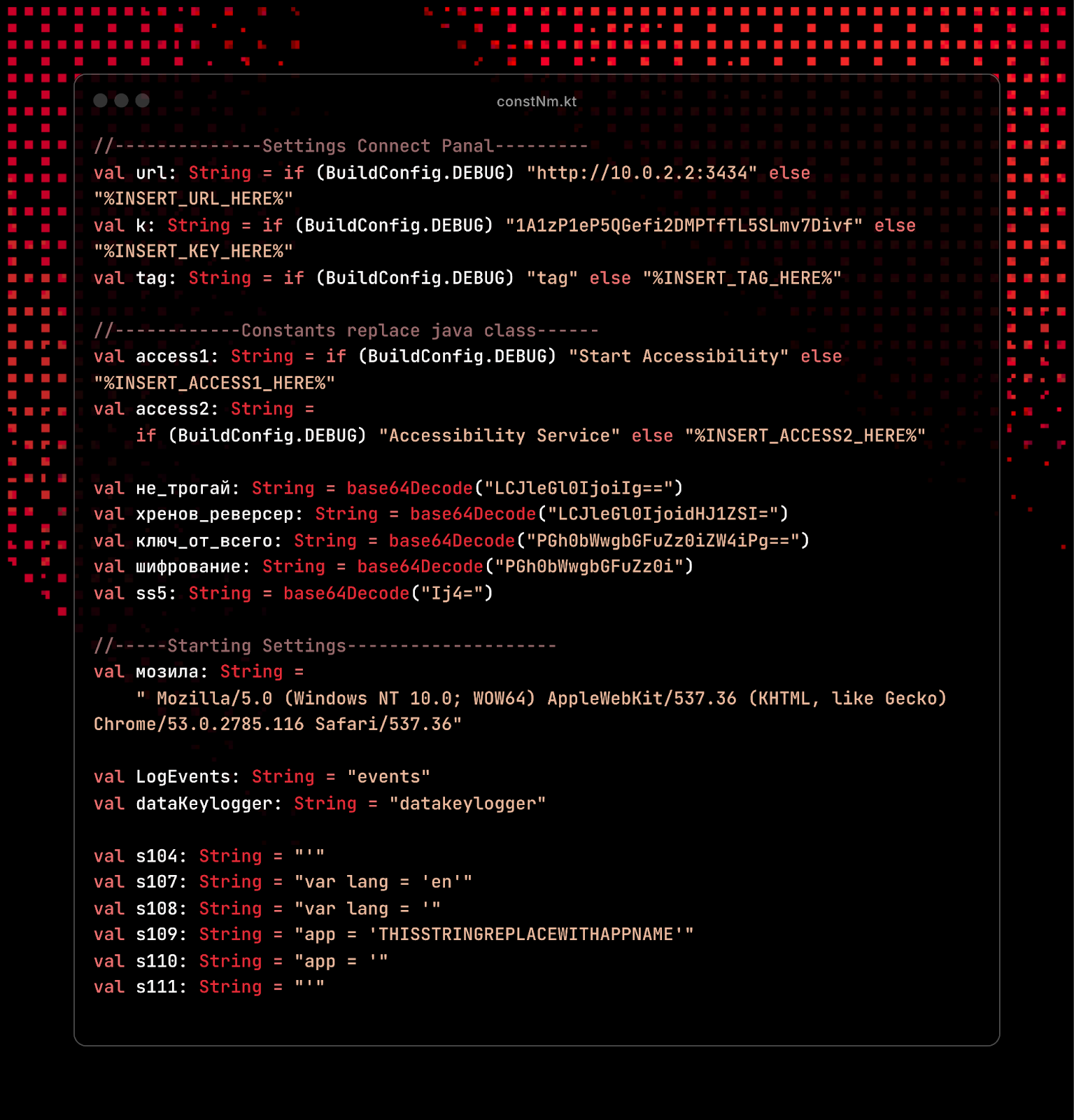 Fig 12: Sample of ERMAC's main configuration file.
Fig 12: Sample of ERMAC's main configuration file.ERMAC encrypts all traffic using AES-CBC PKCS5 padding with the hardcoded nonce "0123456789abcdef". All traffic from the C2 server is decrypted using the same server key and nonce.
Before executing ERMAC checks the phone carrier to ensure that it's not executing in a country within the Commonwealth of Independent States (CIS), a common method by malware developers within that region to avoid persecution. This is further followed by a check to determine if ERMAC is being run in an Emulator. If ERMAC detects either of these to be true, it will uninstall itself and quit.
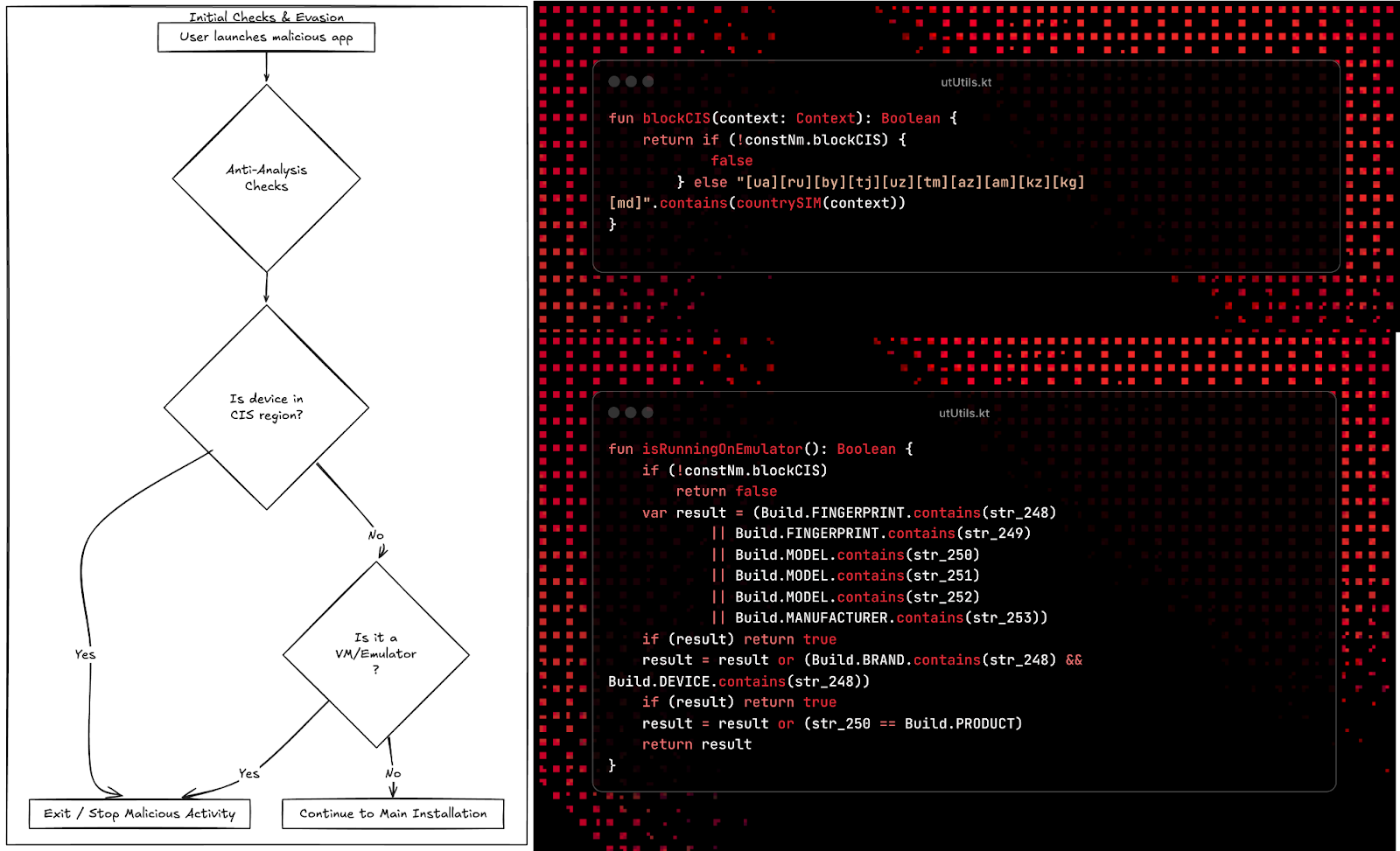 Fig 13: ERMAC Initialization
Fig 13: ERMAC InitializationIf the environment is safe, ERMAC will request elevated permissions so that it can run in the background, access SMS logs, and terminate programs. After ERMAC has installed itself properly, it will send all device information to the exfiltration server and listen for incoming commands.
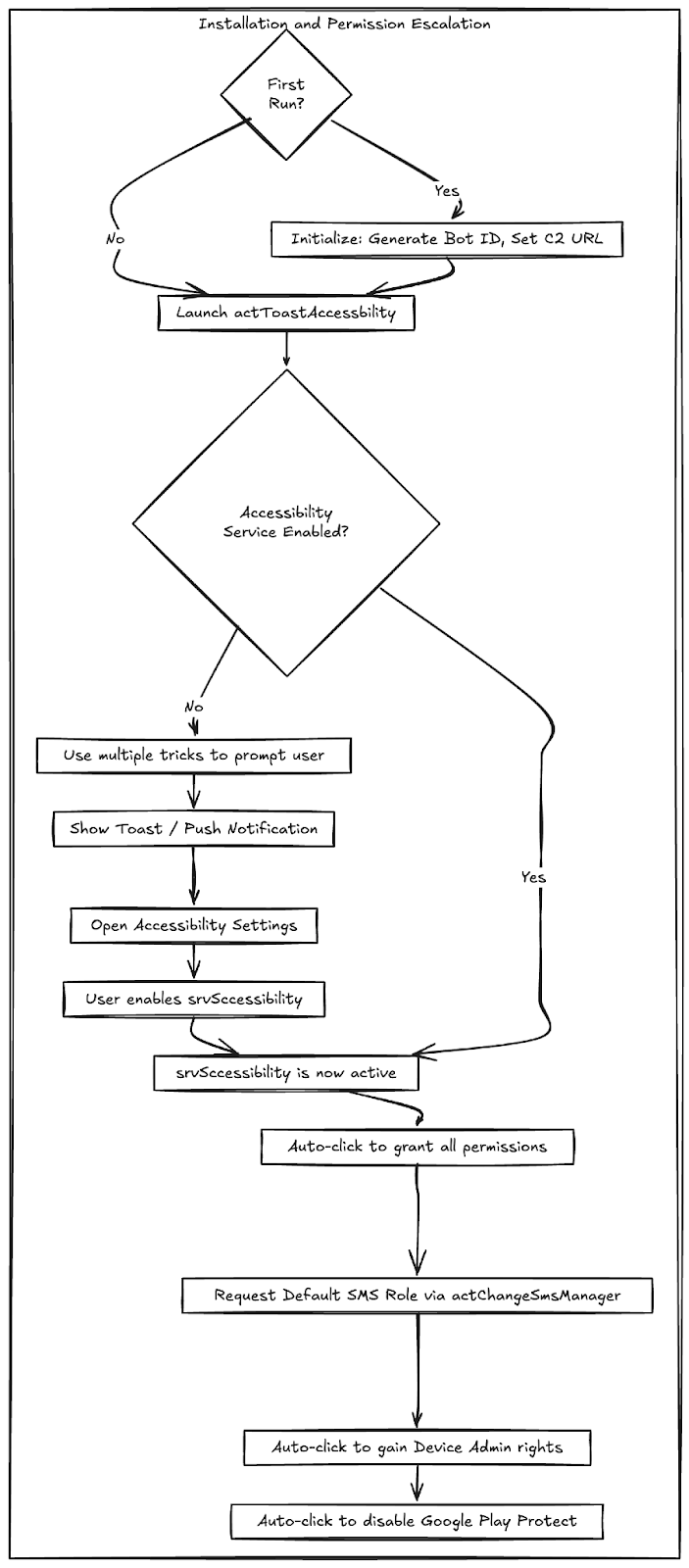 Fig 14: ERMAC Device Provisioning Flow
Fig 14: ERMAC Device Provisioning FlowERMAC supports the following commands:
| Command | Description |
|---|---|
| sendsms | Sends an SMS message to a specified phone number. Can specify the SIM card. |
| startussd | Executes a USSD request (e.g., *100#). Can specify the SIM card. |
| forwardcall | Sets up call forwarding to a specified number. Can specify the SIM card. |
| push | Displays a custom push notification with a specified title, text, and icon. |
| getcontacts | Steals the user's contact list and sends it to the C2 server. |
| getaccounts / logaccounts | Steals a list of registered accounts (e.g., Google) and sends it to the C2. |
| getinstallapps | Gets a list of all installed applications and sends it to the C2. |
| getsms | Steals all SMS messages from the device and sends them to the C2. |
| startinject | Launches a fake overlay (injection) for a target application to steal credentials. |
| openurl | Opens a specified URL in the device's default web browser. |
| sendsmsall | Sends a specified SMS message to every contact in the user's address book. |
| startapp | Launches a specified application. |
| clearcache / clearcash | Attempts to clear the cache of a specified application. |
| calling | Initiates a phone call to a specified number. |
| deleteapplication | Uninstalls a specified application from the device. |
| startadmin | Prompts the user to grant Device Administrator privileges to the malware. |
| killme | Removes the malware itself from the device. |
| updateinjectandlistapps | Forces an update of the injection list and the list of installed applications. |
| gmailtitles | Retrieves the subjects of emails from the Gmail app. |
| getgmailmessage | Retrieves the content of a specific email from the Gmail app. |
| fmmanager | With extra: "ls": Lists files/directories. With extra: "dl": Downloads a file to the C2. |
| takephoto | Takes a picture using the front camera and sends it to the C2 server. |
ERMAC Builder
The final component of the ERMAC banking trojan is its web builder, which provides adversaries the ability to configure and create builds for its malware campaigns. The Web Panel allows adversaries to configure the application name, server URL, and a number of other configuration settings for the Android backdoor.
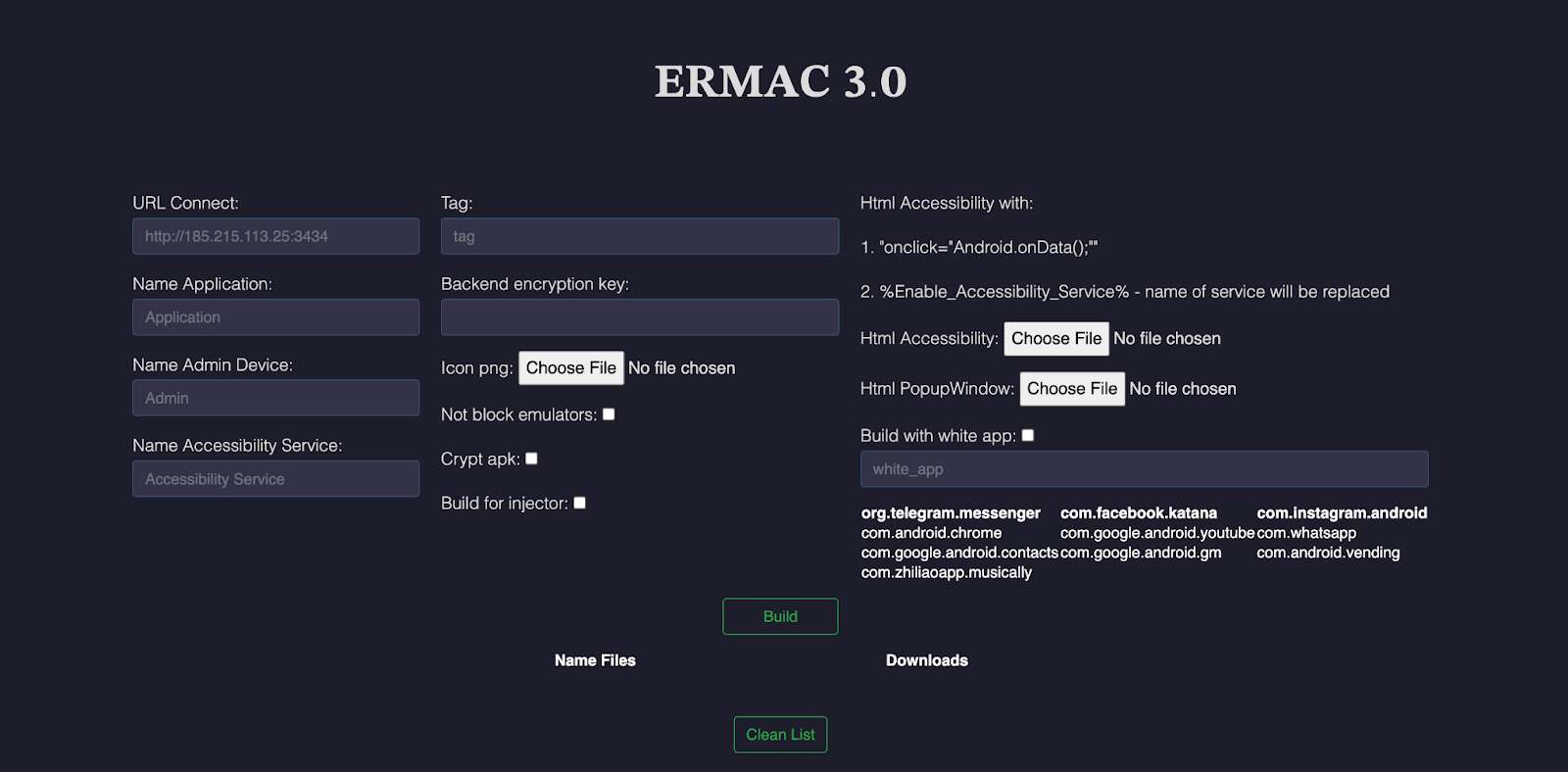 Fig 15: ERMAC Builder Panel UI
Fig 15: ERMAC Builder Panel UIOn each build, ERMAC uses obfuscapk to obfuscate the Android application, giving it a unique hash and obfuscating class names, strings, manifest properties, and more.
Infrastructure Linkages
With each component mapped, we pivoted to identifying how these pieces connect in live environments using HuntSQL™ queries
ERMAC uses a number of identifiable signals for its infrastructure. This equips threat hunters with the ability to quickly find core infrastructure belonging to ERMAC with Hunt's SQL search functionality.
ERMAC Panel
HuntSQL™ query for finding ERMAC 3.0 C2 Panels based on the HTML header title.
SELECT * from httpv2
WHERE html.head.title = 'ERMAC 3.0 PANEL'
CopyWhy it matters: Panels are the operator's main interface for issuing commands and managing stolen data. Identifying them helps track live infrastructure and block access.
ERMAC C2 API
HuntSQL™ query for finding ERMAC 3.0 C2 APIs based on the ermac_session cookie, which is set by default.
SELECT *
FROM httpv2
WHERE http.headers.bytes.content LIKE '%ermac_session%'
CopyWhy it matters: Hosts setting ermac_session are ERMAC backend APIs that handle bot control and data retrieval. Correlating these with panels helps map and confirm active malicious infrastructure.
ERMAC Exfiltration Server
HuntSQL™ query for finding ERMAC exfiltration servers behind basic authentication
SELECT * FROM httpv2
WHERE http.headers.bytes.content LIKE '%LOGIN | ERMAC%'
CopyWhy it matters: These servers receive and store stolen data from infected devices. Blocking egress to them can prevent data exfiltration during an active compromise.
ERMAC Builder
HuntSQL™ query for finding ERMAC 3.0 Builder panels based on the HTML header title.
SELECT * from httpv2
WHERE html.head.title = 'ERMAC 3.0 BUILDER'
CopyWhy it matters: Builder panels are used to create and configure new ERMAC APKs. Discovering them provides early warning of upcoming campaigns and distribution activity.
The queries above allow defenders to locate and monitor live ERMAC infrastructure. The next step is applying this intelligence to defense and disruption efforts
Mitigation Strategies
ERMAC targets users of banking, shopping, and other financial applications primarily through web injects. It relies on Android's WebView API to place an overlay on top of legitimate apps, capturing credentials and payment information. Implementing secure Android permissions such as FLAG_SECURE and using code to detect or block overlays can reduce exposure to this technique.
Defenders can also focus on identifying and disrupting ERMAC infrastructure. Regularly scan for active C2 and exfiltration servers, and block Android applications that reference known ERMAC IPs or domains.
Additional measures include:
Monitoring for unique ERMAC traits such as HTTP headers, hardcoded nonces, and panel titles
Strengthening mobile apps against overlay attacks through runtime detection and code obfuscation
Running proactive threat hunts with Hunt.io's queries to uncover related infrastructure before it is used in campaigns
Where possible, share indicators with trusted threat intel networks and coordinate with hosting providers to take down exposed panels and exfiltration servers.
ERMAC Android Binary Yara Rule
As part of these mitigation efforts, the following YARA rule can be deployed to detect ERMAC Android binaries.
ERMAC consistently uses the package com.amazon.zzz for its builds. The following YARA rule detects Android APKs containing this string, which serves as a unique identifier for ERMAC. It can be used in malware repositories, sandbox systems, and endpoint scanning solutions to flag potential ERMAC infections.
rule Ermac_v3 {
meta:
author = "@huntio"
date = "2025-08-09"
description = "ERMAC Android Backdoor"
version = "1.0"
strings:
$str0 = "com.amazon.zzz" fullword
condition:
uint32be(0) == 0x504B0304
and filesize < 1MB
and $str0
}
CopyConclusion
Hunt.io discovered and obtained the full ERMAC 3.0 source code, giving our team a rare opportunity to examine an active and evolving banking trojan from the inside. The combination of a Laravel-based C2 backend, React control panel, Golang exfiltration service, and obfuscated Android backdoor shows the level of sophistication behind its development. Through this direct access, we identified its expanded targeting across more than 700 financial and cryptocurrency apps, new form injection capabilities, and encryption methods that strengthen its stealth.
Our research also revealed critical weaknesses, including hardcoded credentials, default JWT tokens, and open panel registration. By correlating these flaws with live ERMAC infrastructure, we provide defenders with concrete ways to track, detect, and disrupt active operations. This analysis not only strengthens threat hunting and attribution but also exposes the operational risks of the Malware-as-a-Service model.
MITRE Att&ck Tactics
The following MITRE ATT&CK mapping outlines the techniques ERMAC employs across its lifecycle
| Tactic | Technique | Sub-Technique | Description |
|---|---|---|---|
| Execution | User Execution | N/A | ERMAC is executed through user interaction |
| Execution | Command and Scripting Interpreter | N/A | TERMAC uses WebView components to execute remote JavaScript from its C2 server, for data collection. |
| Persistence | Scheduled Task/Job | N/A | Uses StartReceiver to schedule callbacks to maintain persistence. |
| Persistence | Service | N/A | ERMAC uses ActivityManager to ensure service stays online. |
| Mobile | SMS Control | N/A | Uses Android intents to intercept and control SMS messages. |
| Privilege Escalation | Elevated Execution with Prompt | N/A | Requests Device Administrator privileges to lock the screen and prevent uninstallation. |
| Defense Evasion | Encrypted Channel | N/A | All communication with the C2 server is encrypted using AES, which prevents network-level detection of commands and exfiltrated data. |
| Defense Evasion | Masquerading | N/A | ERMAC deletes its launcher icon after the first run to hide its presence on the device. |
| Defense Evasion | Obfuscated Files or Information | N/A | Strings and variable names are obfuscated with Russian text and Base64 encoding to hinder static analysis. |
| Defense Evasion | Emulator/Sandbox Evasion | N/A | Checks for emulation to prevent analysis. |
| Defense Evasion | Geofencing | N/A | Blocks [ua][ru][by][tj][uz][tm][az][am][kz][kg][md] from running the malware. |
| Defense Evasion | Disable or Modify System Firewall | N/A | Using Accessibility Services, ERMAC disables Google Play Protect to reduce the likelihood of being detected and removed. |
| Credential Access | Input Capture | Keylogging | Includes a keylogger functionality to capture user input across all applications. |
| Credential Access | Input Capture | GUI Input Capture | Utilizes form injection to capture form data from Android applications. |
| Credential Access | Access Notifications | N/A | Intercepts incoming SMS messages to steal sensitive information like two-factor authentication (2FA) codes. |
| Discovery | Account Discovery | N/A | Gathers a list of all user accounts on the device. |
| Discovery | Application Discovery | N/A | Exfiltrates a list of all installed apps. |
| Discovery | System Information Discovery | N/A | Collects detailed device information such as OS version, device model, phone number, and SIM details. |
| Collection | Protected User Data | Contacts List | The malware steals the user's entire contact list. |
| Collection | Protected User Data | SMS Messages | It reads and exfiltrates the user's existing SMS inbox. |
| Collection | Data from Local System | N/A | A built-in file manager module allows the attacker to browse the device's file system and download files. |
| Collection | Video Capture | N/A | It can remotely take photos using the front camera without the user's knowledge. |
| Command and Control | Application Layer Protocol | N/A | Communicates with its C2 server over HTTP/S. |
| Command and Control | Non-Standard Port | N/A | C2 communication may be obscured by using non-standard ports for exfiltration. |
| Command and Control | Fallback Channels | N/A | The malware is configured with a list of backup C2 domains to ensure communication persistence if the primary server fails. |
| Exfiltration | Exfiltration Over C2 Channel | N/A | All collected data, including credentials, contacts, and files, is sent to the attacker using the primary C2 channel. |
ERMAC 3.0 Indicators of Compromise
Network Observables
| IP Address | ASN | Behavior | Last Seen |
|---|---|---|---|
| 43[.]160[.]253[.]145:80 | AS132203 | ERMAC 3.0 Panel | 2025-08-08 |
| 91[.]92[.]46[.]12:80 | AS214196 | ERMAC 3.0 Panel | 2025-07-17 |
| 206[.]123[.]128[.]81:80 | AS207184 | ERMAC 1.0-2.0 Panel | N/A |
| 43[.]160[.]253[.]145:8080 | AS132203 | ERMAC Exfiltration Server | 2025-08-08 |
| 121[.]127[.]231[.]163:8082 | AS152194 | ERMAC Exfiltration Server | 2025-07-11 |
| 121[.]127[.]231[.]198:8082 | AS152194 | ERMAC Exfiltration Server | 2025-07-12 |
| 121[.]127[.]231[.]161:8082 | AS152194 | ERMAC Exfiltration Server | 2025-07-12 |
| 43[.]160[.]253[.]145:8089 | AS132203 | ERMAC C2 Server | 2025-08-08 |
| 172[.]191[.]69[.]182:8089 | AS8075 | ERMAC C2 Server | 2025-07-13 |
| 98[.]71[.]173[.]119:8089 | AS8075 | ERMAC C2 Server | 2025-07-25 |
| 20[.]162[.]226[.]228:8089 | AS8075 | ERMAC C2 Server | 2025-07-25 |
| 141[.]164[.]62[.]236:80 | AS20473 | Open directory with the ERMAC source code. | 2024-03-06 |
| 5[.]188[.]33[.]192:443 | AS202422 | Mentioned in the source code, potentially an outdated panel or C2 server. | N/A |
Host-Based Observables
| Filename | SHA-256 Hash | Behavior |
|---|---|---|
| Ermac 3.0.zip | 175d4adc5fc0b0d8eb4b7d93b6f9694e4a3089e4ed4c59a2828d0667a9992aaa | ERMAC Source Code |
| server_go | 8c81cebbaff9c9cdad69257f50af0f5208a0d5923659b4e0c3319333f9e8d545 | ERMAC compiled exfiltration server |
The full list of ERMAC Form Injects is available in CSV format.

In March 2024, Hunt.io discovered and obtained the complete ERMAC V3.0 source code, giving us a rare opportunity to study a live and actively maintained Malware-as-a-Service platform from the inside. Full source code leaks of active and operational threats are uncommon, and this one offers a unique chance for attribution, infrastructure mapping, and identifying exploitable weaknesses.
Its earliest versions were built using the leaked Cerberus source code, and by late 2023, version 2.0 had incorporated large portions of the Hook botnet's codebase. The newly uncovered version 3.0 reveals a significant evolution of the malware, expanding its form injection and data theft capabilities to target more than 700 banking, shopping, and cryptocurrency applications.
This post examines the backend, frontend panel, exfiltration server, and builder included in the leak, detailing ERMAC's infrastructure, operational techniques, and multiple vulnerabilities that could be leveraged to disrupt its activity.
Key Takeaways
Our analysis of the ERMAC V3.0 leak uncovered technical details, operational weaknesses, and active infrastructure that defenders can use to disrupt ongoing campaigns.
Hunt.io obtained the full ERMAC V3.0 source code, including its PHP and Laravel backend, React-based frontend, Golang exfiltration server, and Android builder panel.
The leak revealed critical weaknesses, such as a hardcoded JWT secret and a static admin bearer token, default root credentials, and open account registration on the admin panel
Version 3.0 expands targeting to more than 700 financial, shopping, and cryptocurrency apps, adds new form injection methods, an overhauled C2 panel, a new Android backdoor, and AES-CBC encrypted communications
Analysis with HuntSQL linked the leaked files to active ERMAC C2 panels, exfiltration servers, and builder deployments still operating online.
Findings confirm ERMAC's role as a maintained Malware-as-a-Service platform, giving operators flexible control over targeting, encryption keys, and campaign creation
Initial Discovery
The investigation began on March 6th, 2024, when our research team, using the AttackCapture™ tool, identified an open directory on 141[.]164[.]62[.]236:443 containing an archive titled Ermac 3.0.zip. This archive held the complete ERMAC V3.0 source code.
 Fig 01: Open directory containing ERMAC's source code, discovered by Hunt.io
Fig 01: Open directory containing ERMAC's source code, discovered by Hunt.ioUpon further analysis, the Ermac 3.0.zip archive was found to contain 5 different directories:
backend: The ERMAC C2 backend, written in PHP.
frontend: The ERMAC C2 frontend, written in React.
golang: A Go binary that configures an HTTP server used in the exfiltration of data.
docker: Docker configuration files.
builder: Source code to ERMAC 3.0 banking trojan and a panel allowing for compilation and obfuscation of the APK.
Backend C2 Server
Looking into ERMAC's backend source code, we can see it's developed in PHP and uses Laravel as its backend framework. The codebase shares no overlap with the leaked Cerebus source code, with it implementing different routing, infrastructure logic, and features.
| Method | Route | Auth Required |
|---|---|---|
| POST | /api/v1/sign-in | No |
| POST | /api/v1/smartInjections/{sessionId} | No |
| POST | /api/v1/smartInjections/session/list | No |
| PUT | /api/v1/smartInjections/session/{session} | No |
| GET | /api/v1/getUserInfo | Yes |
| POST | /api/v1/injects/getInjectionsList | Yes |
| POST | /api/v1/injects/createInjection | Yes |
| DELETE | /api/v1/injects/deleteInjection | Yes |
| POST | /api/v1/injects/{injection}/editInjection | Yes |
| POST | /api/v1/sendBotsCommand | Yes |
| DELETE | /api/v1/deleteBot | Yes |
| DELETE | /api/v1/deleteAllRemovedApp | Yes |
| PUT | /api/v1/{bot}/setBotType | Yes |
| GET | /api/v1/{bot}/commands/getCommandsList | Yes |
| PUT | /api/v1/{bot}/settings/updateBotSettings | Yes |
| PUT | /api/v1/{bot}/injects/updateBotInjections | Yes |
| DELETE | /api/v1/deleteLog | Yes |
| PUT | /api/v1/editLogComment | Yes |
| POST | /api/v1/accounts/getAccountsList | Yes |
| POST | /api/v1/accounts/createAccount | Yes |
| PUT | /api/v1/accounts/{user}/editAccount | Yes |
| DELETE | /api/v1/accounts/{user}/deleteAccount | Yes |
| POST | /api/v1/permissions/getPermissionsList | Yes |
| PUT | /api/v1/permissions/updatePermission | Yes |
| POST | /api/v1/counts/getCounts | Yes |
| POST | /api/v1/counts/getStats | Yes |
| POST | /api/v1/autoCommands/getAutoCommandsList | Yes |
| PUT | /api/v1/autoCommands/updateAutoCommand | Yes |
| POST | /api/v1/search | Yes |
Reviewing these routes reveals the scope of control ERMAC operators have over infected devices and stolen data.
The ERMAC backend provides operators the ability to manage victim devices and access compromised data, such as SMS logs, stolen accounts, and device data.
ERMAC primarily leverages form injects for capturing sensitive data, which is done by serving custom form injects through the public/injects directory.
 Fig 02: ERMAC's backend directory containing form injects for popular financial apps.
Fig 02: ERMAC's backend directory containing form injects for popular financial apps.ERMAC targets primarily financial applications with a large focus on mobile banking and cryptocurrency applications with it, capturing sensitive data such as login credentials or credit card data.
 Fig 03: Form Inject mimicking a banking app, and its callback function for exfiltrating form data.
Fig 03: Form Inject mimicking a banking app, and its callback function for exfiltrating form data.ERMAC will fetch and inject its own custom HTML page into 700+ different applications that uses the callback function
Android.send_log_injects to exfiltrate form data.
ERMAC's backend uses the
ermac_session cookie to handle authentication, which allows us to pivot and find other active backends. Using Hunt's SQL search, we are able to find 4 more unique ERMAC C2 servers in the wild:
SELECT * FROM httpv2
WHERE http.headers.bytes.content
LIKE '%ermac_session%'
CopyOutput:
 Fig 04: ERMAC C2 Servers observed having the ermac_session cookie.
Fig 04: ERMAC C2 Servers observed having the ermac_session cookie.Upon further analysis, ERMAC has three vulnerabilities: a hardcoded JWT token "
h3299xK7gdARLk85rsMyawT7K4yGbxYbkKoJo8gO3lMdl9XwJCKh2tMkdCmeeSeK", the hardcoded credentials for root with the password changemeplease, and the ability to register an account directly through the API, allowing for full access to the ERMAC admin panel.
 Fig 05: Hardcoded default credentials for ERMAC
Fig 05: Hardcoded default credentials for ERMACFrontend Panel
To complement the Backend C2, ERMAC provides a panel for interacting with the backend. ERMAC is observed to have three public versions, with the latest known version being 3.0
 Fig 06: ERMAC V3.0 Panel Login
Fig 06: ERMAC V3.0 Panel LoginAll ERMAC panels notably have the page title "ERMAC 3.0 PANEL" allowing us to find 43[.]160[.]253[.]145 and 91[.]92[.]46[.]12. Upon simplifying this query, we can find an additional IP belonging to an older ERMAC panel: 206[.]123[.]128[.]81
SELECT * from httpv2
WHERE html.head.title = 'ERMAC 3.0 PANEL'
CopyOutput:
 Fig 07: Results from searching for hosts with the ermac_session cookie, observed via HuntSQL by Hunt.io
Fig 07: Results from searching for hosts with the ermac_session cookie, observed via HuntSQL by Hunt.ioFrom within the panel, operators are able to interact with connected devices by issuing commands or accessing stolen data.
 Fig 08: ERMAC Panel UI
Fig 08: ERMAC Panel UIThis is accompanied by the ability to manage form injects directly through the panel, with the ability to enable or disable targeting of specific applications.
 Fig 09: Form inject management system with adversaries able to upload and modify targeted applications.
Fig 09: Form inject management system with adversaries able to upload and modify targeted applications.Exfiltration Server
ERMAC is observed using a second server for exfiltrating stolen data. The exfiltration server is developed in Golang and provides an encrypted HTTP API for receiving exfiltrated data and managing information related to compromised devices.
 Fig 10: server_go exfiltration binary with the functions and libraries used.
Fig 10: server_go exfiltration binary with the functions and libraries used.The usage of a separate server is likely to hide the main C2 panel, with operators able to use isolated servers for exfiltration.
ERMAC exfiltration servers are commonly seen using HTTP basic authentication with the following header
Www-Authenticate: Basic realm="LOGIN | ERMAC". By querying Hunt's SQL httpv2 dataset, we were able to identify four more unique exfiltration servers used by ERMAC.
SELECT * FROM httpv2
WHERE http.headers.bytes.content like '%LOGIN | ERMAC%'
CopyOutput:
 Fig 11: Public ERMAC Exfiltration Servers found with HuntSQL™
Fig 11: Public ERMAC Exfiltration Servers found with HuntSQL™ERMAC Backdoor
ERMAC leverages an Android backdoor developed in Kotlin, which provides control of the compromised device. The Android application supports 71 different languages, with it providing operators the ability to configure encryption keys, C2 servers, and the application settings.
 Fig 12: Sample of ERMAC's main configuration file.
Fig 12: Sample of ERMAC's main configuration file.ERMAC encrypts all traffic using AES-CBC PKCS5 padding with the hardcoded nonce "0123456789abcdef". All traffic from the C2 server is decrypted using the same server key and nonce.
Before executing ERMAC checks the phone carrier to ensure that it's not executing in a country within the Commonwealth of Independent States (CIS), a common method by malware developers within that region to avoid persecution. This is further followed by a check to determine if ERMAC is being run in an Emulator. If ERMAC detects either of these to be true, it will uninstall itself and quit.
 Fig 13: ERMAC Initialization
Fig 13: ERMAC InitializationIf the environment is safe, ERMAC will request elevated permissions so that it can run in the background, access SMS logs, and terminate programs. After ERMAC has installed itself properly, it will send all device information to the exfiltration server and listen for incoming commands.
 Fig 14: ERMAC Device Provisioning Flow
Fig 14: ERMAC Device Provisioning FlowERMAC supports the following commands:
| Command | Description |
|---|---|
| sendsms | Sends an SMS message to a specified phone number. Can specify the SIM card. |
| startussd | Executes a USSD request (e.g., *100#). Can specify the SIM card. |
| forwardcall | Sets up call forwarding to a specified number. Can specify the SIM card. |
| push | Displays a custom push notification with a specified title, text, and icon. |
| getcontacts | Steals the user's contact list and sends it to the C2 server. |
| getaccounts / logaccounts | Steals a list of registered accounts (e.g., Google) and sends it to the C2. |
| getinstallapps | Gets a list of all installed applications and sends it to the C2. |
| getsms | Steals all SMS messages from the device and sends them to the C2. |
| startinject | Launches a fake overlay (injection) for a target application to steal credentials. |
| openurl | Opens a specified URL in the device's default web browser. |
| sendsmsall | Sends a specified SMS message to every contact in the user's address book. |
| startapp | Launches a specified application. |
| clearcache / clearcash | Attempts to clear the cache of a specified application. |
| calling | Initiates a phone call to a specified number. |
| deleteapplication | Uninstalls a specified application from the device. |
| startadmin | Prompts the user to grant Device Administrator privileges to the malware. |
| killme | Removes the malware itself from the device. |
| updateinjectandlistapps | Forces an update of the injection list and the list of installed applications. |
| gmailtitles | Retrieves the subjects of emails from the Gmail app. |
| getgmailmessage | Retrieves the content of a specific email from the Gmail app. |
| fmmanager | With extra: "ls": Lists files/directories. With extra: "dl": Downloads a file to the C2. |
| takephoto | Takes a picture using the front camera and sends it to the C2 server. |
ERMAC Builder
The final component of the ERMAC banking trojan is its web builder, which provides adversaries the ability to configure and create builds for its malware campaigns. The Web Panel allows adversaries to configure the application name, server URL, and a number of other configuration settings for the Android backdoor.
 Fig 15: ERMAC Builder Panel UI
Fig 15: ERMAC Builder Panel UIOn each build, ERMAC uses obfuscapk to obfuscate the Android application, giving it a unique hash and obfuscating class names, strings, manifest properties, and more.
Infrastructure Linkages
With each component mapped, we pivoted to identifying how these pieces connect in live environments using HuntSQL™ queries
ERMAC uses a number of identifiable signals for its infrastructure. This equips threat hunters with the ability to quickly find core infrastructure belonging to ERMAC with Hunt's SQL search functionality.
ERMAC Panel
HuntSQL™ query for finding ERMAC 3.0 C2 Panels based on the HTML header title.
SELECT * from httpv2
WHERE html.head.title = 'ERMAC 3.0 PANEL'
CopyWhy it matters: Panels are the operator's main interface for issuing commands and managing stolen data. Identifying them helps track live infrastructure and block access.
ERMAC C2 API
HuntSQL™ query for finding ERMAC 3.0 C2 APIs based on the ermac_session cookie, which is set by default.
SELECT *
FROM httpv2
WHERE http.headers.bytes.content LIKE '%ermac_session%'
CopyWhy it matters: Hosts setting ermac_session are ERMAC backend APIs that handle bot control and data retrieval. Correlating these with panels helps map and confirm active malicious infrastructure.
ERMAC Exfiltration Server
HuntSQL™ query for finding ERMAC exfiltration servers behind basic authentication
SELECT * FROM httpv2
WHERE http.headers.bytes.content LIKE '%LOGIN | ERMAC%'
CopyWhy it matters: These servers receive and store stolen data from infected devices. Blocking egress to them can prevent data exfiltration during an active compromise.
ERMAC Builder
HuntSQL™ query for finding ERMAC 3.0 Builder panels based on the HTML header title.
SELECT * from httpv2
WHERE html.head.title = 'ERMAC 3.0 BUILDER'
CopyWhy it matters: Builder panels are used to create and configure new ERMAC APKs. Discovering them provides early warning of upcoming campaigns and distribution activity.
The queries above allow defenders to locate and monitor live ERMAC infrastructure. The next step is applying this intelligence to defense and disruption efforts
Mitigation Strategies
ERMAC targets users of banking, shopping, and other financial applications primarily through web injects. It relies on Android's WebView API to place an overlay on top of legitimate apps, capturing credentials and payment information. Implementing secure Android permissions such as FLAG_SECURE and using code to detect or block overlays can reduce exposure to this technique.
Defenders can also focus on identifying and disrupting ERMAC infrastructure. Regularly scan for active C2 and exfiltration servers, and block Android applications that reference known ERMAC IPs or domains.
Additional measures include:
Monitoring for unique ERMAC traits such as HTTP headers, hardcoded nonces, and panel titles
Strengthening mobile apps against overlay attacks through runtime detection and code obfuscation
Running proactive threat hunts with Hunt.io's queries to uncover related infrastructure before it is used in campaigns
Where possible, share indicators with trusted threat intel networks and coordinate with hosting providers to take down exposed panels and exfiltration servers.
ERMAC Android Binary Yara Rule
As part of these mitigation efforts, the following YARA rule can be deployed to detect ERMAC Android binaries.
ERMAC consistently uses the package com.amazon.zzz for its builds. The following YARA rule detects Android APKs containing this string, which serves as a unique identifier for ERMAC. It can be used in malware repositories, sandbox systems, and endpoint scanning solutions to flag potential ERMAC infections.
rule Ermac_v3 {
meta:
author = "@huntio"
date = "2025-08-09"
description = "ERMAC Android Backdoor"
version = "1.0"
strings:
$str0 = "com.amazon.zzz" fullword
condition:
uint32be(0) == 0x504B0304
and filesize < 1MB
and $str0
}
CopyConclusion
Hunt.io discovered and obtained the full ERMAC 3.0 source code, giving our team a rare opportunity to examine an active and evolving banking trojan from the inside. The combination of a Laravel-based C2 backend, React control panel, Golang exfiltration service, and obfuscated Android backdoor shows the level of sophistication behind its development. Through this direct access, we identified its expanded targeting across more than 700 financial and cryptocurrency apps, new form injection capabilities, and encryption methods that strengthen its stealth.
Our research also revealed critical weaknesses, including hardcoded credentials, default JWT tokens, and open panel registration. By correlating these flaws with live ERMAC infrastructure, we provide defenders with concrete ways to track, detect, and disrupt active operations. This analysis not only strengthens threat hunting and attribution but also exposes the operational risks of the Malware-as-a-Service model.
MITRE Att&ck Tactics
The following MITRE ATT&CK mapping outlines the techniques ERMAC employs across its lifecycle
| Tactic | Technique | Sub-Technique | Description |
|---|---|---|---|
| Execution | User Execution | N/A | ERMAC is executed through user interaction |
| Execution | Command and Scripting Interpreter | N/A | TERMAC uses WebView components to execute remote JavaScript from its C2 server, for data collection. |
| Persistence | Scheduled Task/Job | N/A | Uses StartReceiver to schedule callbacks to maintain persistence. |
| Persistence | Service | N/A | ERMAC uses ActivityManager to ensure service stays online. |
| Mobile | SMS Control | N/A | Uses Android intents to intercept and control SMS messages. |
| Privilege Escalation | Elevated Execution with Prompt | N/A | Requests Device Administrator privileges to lock the screen and prevent uninstallation. |
| Defense Evasion | Encrypted Channel | N/A | All communication with the C2 server is encrypted using AES, which prevents network-level detection of commands and exfiltrated data. |
| Defense Evasion | Masquerading | N/A | ERMAC deletes its launcher icon after the first run to hide its presence on the device. |
| Defense Evasion | Obfuscated Files or Information | N/A | Strings and variable names are obfuscated with Russian text and Base64 encoding to hinder static analysis. |
| Defense Evasion | Emulator/Sandbox Evasion | N/A | Checks for emulation to prevent analysis. |
| Defense Evasion | Geofencing | N/A | Blocks [ua][ru][by][tj][uz][tm][az][am][kz][kg][md] from running the malware. |
| Defense Evasion | Disable or Modify System Firewall | N/A | Using Accessibility Services, ERMAC disables Google Play Protect to reduce the likelihood of being detected and removed. |
| Credential Access | Input Capture | Keylogging | Includes a keylogger functionality to capture user input across all applications. |
| Credential Access | Input Capture | GUI Input Capture | Utilizes form injection to capture form data from Android applications. |
| Credential Access | Access Notifications | N/A | Intercepts incoming SMS messages to steal sensitive information like two-factor authentication (2FA) codes. |
| Discovery | Account Discovery | N/A | Gathers a list of all user accounts on the device. |
| Discovery | Application Discovery | N/A | Exfiltrates a list of all installed apps. |
| Discovery | System Information Discovery | N/A | Collects detailed device information such as OS version, device model, phone number, and SIM details. |
| Collection | Protected User Data | Contacts List | The malware steals the user's entire contact list. |
| Collection | Protected User Data | SMS Messages | It reads and exfiltrates the user's existing SMS inbox. |
| Collection | Data from Local System | N/A | A built-in file manager module allows the attacker to browse the device's file system and download files. |
| Collection | Video Capture | N/A | It can remotely take photos using the front camera without the user's knowledge. |
| Command and Control | Application Layer Protocol | N/A | Communicates with its C2 server over HTTP/S. |
| Command and Control | Non-Standard Port | N/A | C2 communication may be obscured by using non-standard ports for exfiltration. |
| Command and Control | Fallback Channels | N/A | The malware is configured with a list of backup C2 domains to ensure communication persistence if the primary server fails. |
| Exfiltration | Exfiltration Over C2 Channel | N/A | All collected data, including credentials, contacts, and files, is sent to the attacker using the primary C2 channel. |
ERMAC 3.0 Indicators of Compromise
Network Observables
| IP Address | ASN | Behavior | Last Seen |
|---|---|---|---|
| 43[.]160[.]253[.]145:80 | AS132203 | ERMAC 3.0 Panel | 2025-08-08 |
| 91[.]92[.]46[.]12:80 | AS214196 | ERMAC 3.0 Panel | 2025-07-17 |
| 206[.]123[.]128[.]81:80 | AS207184 | ERMAC 1.0-2.0 Panel | N/A |
| 43[.]160[.]253[.]145:8080 | AS132203 | ERMAC Exfiltration Server | 2025-08-08 |
| 121[.]127[.]231[.]163:8082 | AS152194 | ERMAC Exfiltration Server | 2025-07-11 |
| 121[.]127[.]231[.]198:8082 | AS152194 | ERMAC Exfiltration Server | 2025-07-12 |
| 121[.]127[.]231[.]161:8082 | AS152194 | ERMAC Exfiltration Server | 2025-07-12 |
| 43[.]160[.]253[.]145:8089 | AS132203 | ERMAC C2 Server | 2025-08-08 |
| 172[.]191[.]69[.]182:8089 | AS8075 | ERMAC C2 Server | 2025-07-13 |
| 98[.]71[.]173[.]119:8089 | AS8075 | ERMAC C2 Server | 2025-07-25 |
| 20[.]162[.]226[.]228:8089 | AS8075 | ERMAC C2 Server | 2025-07-25 |
| 141[.]164[.]62[.]236:80 | AS20473 | Open directory with the ERMAC source code. | 2024-03-06 |
| 5[.]188[.]33[.]192:443 | AS202422 | Mentioned in the source code, potentially an outdated panel or C2 server. | N/A |
Host-Based Observables
| Filename | SHA-256 Hash | Behavior |
|---|---|---|
| Ermac 3.0.zip | 175d4adc5fc0b0d8eb4b7d93b6f9694e4a3089e4ed4c59a2828d0667a9992aaa | ERMAC Source Code |
| server_go | 8c81cebbaff9c9cdad69257f50af0f5208a0d5923659b4e0c3319333f9e8d545 | ERMAC compiled exfiltration server |
The full list of ERMAC Form Injects is available in CSV format.
Related Posts:
Get biweekly intelligence to hunt adversaries before they strike.
Latest News
Hunt Intelligence, Inc.
Get biweekly intelligence to hunt adversaries before they strike.
Latest News
Hunt Intelligence, Inc.
Get biweekly intelligence to hunt adversaries before they strike.
Latest News
Hunt Intelligence, Inc.





